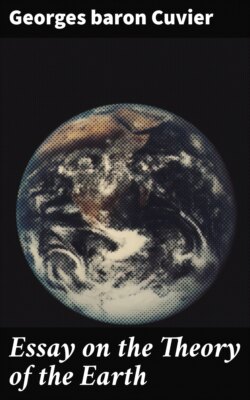Читать книгу Essay on the Theory of the Earth - Georges baron Cuvier - Страница 31
На сайте Литреса книга снята с продажи.
High importance of the Fossil Bones of Quadrupeds.
ОглавлениеTable of Contents
It is obvious, in fact, that the fossil bones of quadrupeds must lead to more accurate conclusions than any other remains of organized bodies, and that for several reasons.
In the first place, they indicate much more clearly the nature of the revolutions to which they have already been subjected. Shells certainly announce the fact, that the sea has once existed in the places where they have been formed; but the changes which have taken place in their species, when rigorously inquired into, may have arisen from slight changes in the nature of the fluid in which they lived, or merely in its temperature. They may even have been produced by causes still more accidental. We can never be perfectly assured that certain species, and even genera, inhabiting the bottom of the sea, and occupying certain fixed spaces, for a longer or shorter time, may not have been driven away and supplanted by other species or genera.
In regard to quadrupeds, on the contrary, every thing is precise. The appearance of their bones in strata, and still more of their entire carcases, announces, either that the stratum itself which contains them has, at a former period, been laid dry, or, at least, that dry land must have existed in its neighbourhood. Their disappearance renders it certain, that this stratum has been inundated, or that the dry land in question has ceased to exist. It is from them, therefore, that we learn with perfect certainty the important fact of repeated irruptions of the sea, which the shells and other marine productions could not of themselves have proved; and it is by a careful investigation of them, that we may hope to ascertain the number and the epochs of these irruptions.
Secondly, The nature of the revolutions which have altered the surface of the globe, must have exerted a more powerful action upon terrestrial quadrupeds, than upon marine animals. As these revolutions have consisted chiefly of changes in the bed of the sea, and as the waters must have destroyed all the quadrupeds which they reached, if their irruption was general, it would necessarily have destroyed the entire class; or if it only overwhelmed certain continents at one time, it would at least have destroyed the species peculiar to those continents, without having the same effect upon the marine animals. On the other hand, millions of aquatic animals would have been left dry, or buried under newly-formed strata, or thrown violently on the coasts; while their races would still have been preserved in some more peaceful parts of the sea, whence they might again be propagated after the agitation of the waters had ceased.
Thirdly, This more complete action is also more easily ascertained. It is more easy to demonstrate its effects, because, the number of quadrupeds being limited, and the greater part of their species, at least the large ones, being known, we have more means of determining whether fossil bones belong to them, or to a species that is now lost. As, on the other hand, we are very far from being acquainted with all the testaceous animals and fishes which inhabit the sea, and as we are still probably ignorant of the greater number of those which live in deep water, it is impossible to know with certainty, whether a species which occurs in a fossil state, may not still exist somewhere alive. And hence, we see naturalists persisting in giving the name of pelagic shells, that is to say, shells inhabiting the open sea, to the belemnites, cornua-ammonis, and other testaceous remains, which have hitherto been found only in the older strata; meaning by this, that if they have not yet been discovered in a living state, it is because they inhabit the depths of the sea, far beyond the reach of our nets.
